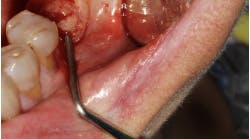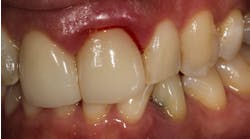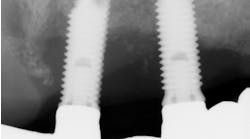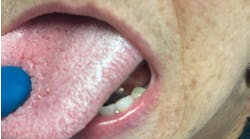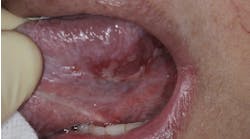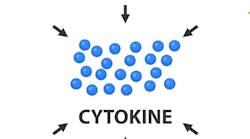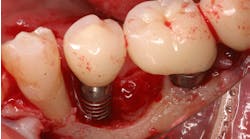First evidence-based diagnostic criteria for TMD developed by dental researchers
Feb. 7, 2014
In the past, diagnostic criteria for temporomandibular disorders (TMD), which affect an estimated 10% to 15% of Americans, have been based on a consensus of expert opinions and often reflect a shared clinical perspective. None had been rigorously tested by scientists. That has changed. Richard Ohrbach, DDS, PhD, at the University at Buffalo School of Dental Medicine, has collaborated with a number of scientists at other universities on the development of the first evidence-based, diagnostic criteria to help health professionals better diagnose TMD, or TMJ as it is commonly known. This protocol, called the Diagnostic Criteria for TMD (DC/TMD), emerged out of a pivotal workshop in Miami five years ago which Ohrbach lead. The resulting criteria were published this week in the winter issue of the Journal of Oral and Facial Pain and Headache. Ohrbach, who is co-lead author on the paper, says that TMD has historically been a controversial set of clinical problems, and many views have emerged within the dental profession regarding the nature of the disorders and how best to evaluate and diagnose patients. “Legitimizing a problem that affects 10% of the population, in terms of having a diagnosable disorder, and more than 50% of the population in terms of having transient symptoms that come and go on their own, is extremely important for society and health-care delivery,” says Dr. Ohrbach. An international authority on aspects of jaw pain disorders, Dr. Ohrbach collaborated in 2011 and again in 2013 with other U.S. researchers to publish the largest clinical study of pain conditions and how they develop that has ever been done. These research findings were part of the Orofacial Pain Prospective Evaluation and Risk Assessment (OPPERA) study, which followed 3,200 initially pain-free individuals for three to five years. Dr. Ohrbach says he and independent researchers from around the world have been involved in diagnostic research to develop scientifically tested criteria for the evaluation and diagnosis of TMD for 25 years. The new criteria, supported in part by the National Institutes of Health (NIH), comprise an improved screening tool as well as formal evaluation methods to help researchers and health professionals, including dentists, more readily differentiate the most common forms of TMD and reach accurate diagnoses that are grounded in supportive scientific evidence. Dr. Ohrbach explains that although TMD is commonly considered a jaw problem, researchers have determined that most people with chronic temporomandibular problems also contend with other ailments. In 1992, the Research Diagnostic Criteria for TMD (RDC/TMD) reflected this awareness. Those criteria were the first to integrate biological, psychological, and social factors into two distinct domains, or axes. "We designed Axis I to evaluate the physical diagnoses, while Axis II characterized the nature of a person's pain, distress, and disability," says Dr. Ohrbach. "The criteria were then translated into 18 languages and became the most widely used diagnostic system among TMD researchers." In the early 2000s, the NIH's National Institute of Dental and Craniofacial Research (NIDCR) funded a group of experts, including Dr. Ohrbach, to lead the first comprehensive assessment of the criteria. The group found Axis I in particular to be less valid than previously thought, leading to a mandate from the TMD clinical and research communities to revise the criteria. The current criteria, the DC/TMD, emerged after the empirical part of the project (Validation Project: 2001 – 2007) was complete and published. Dr. Ohrbach was a co-PI on the Validation Project. The next phase of the project was an international workshop held in Miami, which he chaired, that involved 35 experts from a wide range of disciplines including dentistry, psychology, radiology, neuroscience, medical ontology, and patient advocacy, to name a few. Now, says Dr. Ohrbach, the DC/TMD criteria start with a refined version of Axis I, the physical assessment. If TMD is detected, the protocol moves on to newly crafted diagnostic criteria to help practitioners differentiate among the common subtypes. "In field tests, the diagnostic criteria for painful TMD were found to have at least 86% sensitivity and 97% specificity," he says. "Sensitivity refers to how well a test identifies a person with a given ailment, while specificity characterizes the ability to identify correctly those who are not affected." Axis II, the psychosocial assessment, has a shorter version to screen patients in order to assess pain location, pain intensity, pain-related disability, psychological distress, degree of jaw dysfunction, and presence of oral behaviors (such as clenching the teeth or bracing the jaw) that may contribute to the TMD, he says. If more information is needed, a longer, more comprehensive, version is available to better measure these same constructs as well as a few additional ones. All of these instruments have been scientifically validated. Dr. Ohrbach says the next step is a one-day workshop in June in Cape Town, South Africa, to explore the next set of research questions that pertain to patient evaluation and classification. “My colleagues at UB are also continuing their work on the diagnosis of TMD. Werner Cuesters, PhD, is working on the next generation approach to disease classification for TMD and orofacial pain — that of bioinformatics and medical ontology — using a lot of our TMD data,” he says. “And Yoly M. Gonzalez, DDS, MS, is working on international training in support of the dissemination of the criteria. “Many people in the pain research community worldwide are very interested in what we are doing as next steps.”MORE NEWS FROM THE UNIVERSITY AT BUFFALO ...UB dean chairs international symposium on oral and systemic healthUB gets $1 million HRSA grant to educate nurses on oral healthStudy shows nasal spray anesthesia may work as well as injections for dental proceduresPostmenopausal women who smoked are more likely to lose teeth due to periodontal disease SOURCE: The University at Buffalo

